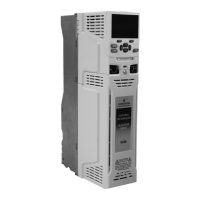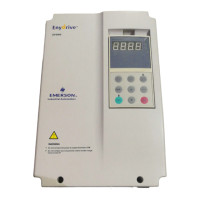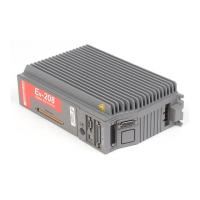Safety
information
Product
information
Mechanical
installation
Electrical
installation
Getting
started
User Menu A Commissioning
Advanced
Parameters
Diagnostics Optimization CT MODBUS RTU Technical Data
E300 Design Guide 199
Issue Number: 1
RFC-S
Motor Rated Speed (B07) is not used by the motor control algorithms, but it is used by the motor thermal protection system.
Open Loop Control Mode (B09) defines the drive output mode, which can either be a voltage mode or a current mode as given below. It should be
noted that the maximum output voltage of the drive is limited to a level just below D.C. Bus Voltage (J65) / √2. Therefore, if the drive is being supplied
via its own rectifier input stage the output voltage is limited to a level just below that of the supply voltage. If the drive is operating in voltage mode the
output voltage is limited to Motor Rated Voltage (B03) or the maximum possible output voltage whichever is the lowest. (If Quasi Square Enable (B45)
= 1 the maximum possible output voltage can be increased. See Quasi Square Enable (B45) for details.)
0: Ur S (Resistance compensation, stator resistance measured at each start)
Resistance compensation is a form of stator flux oriented sensorless motor control. A linear frequency to voltage characteristic is used where the
drive output voltage is increased from 0V to Motor Rated Voltage (B03). as the |Output Frequency (J60)| increases from 0 Hz to Motor Rated
Frequency (B06). When the |Output Frequency (J60)| is above Motor Rated Frequency (B06) the output voltage is limited to Motor Rated Voltage
(B03). Vector based stator resistance compensation is applied below Motor Rated Frequency (B06)/4 and then this is tapered out from Motor Rated
Frequency (B06)/4 to Motor Rated Frequency (B06)/2. This method controls the flux level correctly in the motor in the steady state provided the
correct value of Stator Resistance (B34) is used.
The Stator Resistance (B34) is measured each time the drive is started. This test can only be done with a stationary motor where the flux has
decayed to zero. Therefore this mode should only be used if the motor is guaranteed to be stationary each time the drive is enabled. To ensure that
the measurement is not carried out before the flux has decayed, there is a period of one second after the inverter has been disabled during which the
test is not carried out if the drive is re-started. The Stator Resistance (B34)
is not automatically saved in non-vo
latile memory after each test.
1: Ur (Resistance compensation with no stator resistance measurement)
Resistance compensation is used as in Ur S mode, but the Stator Resistance (B34) is not measured.
2: Fixed (Fixed boost with linear characteristic)
A fixed frequency to voltage characteristic is used as shown below where the voltage at 0 Hz is defined by Low Frequency Voltage Boost (B12).
Figure 8-3 Fixed Boost Linear Characteristic
3: Ur Auto (Resistance compensation, stator resistance measured on first start)
Resistance compensation is used as in Ur S mode, but the Stator Resistance (B34) is only measured once when the drive is first enabled. After the
B09 Open Loop Control Mode
Mode Open-Loop
Minimum 0 Maximum 4
Default 4 Units
Type 8 Bit User Save Update Rate Background read
Display Format Standard Decimal Places 0
Coding RW, TE
Value Text
0Ur S
1Ur
2Fixed
3Ur Auto
4Ur I
Low
Frequency
Voltage Boost
(
B12
)
Rated Voltage
(
B03
) / 2
Rated Voltage
(
B03
)
Output Frequency
(
J60
)
Rated Frequency
(
B06
)
Rated Frequency
(
B06
) / 2
Output Voltage
(
J61
)
Fixed boost frequency to voltage characteristic

